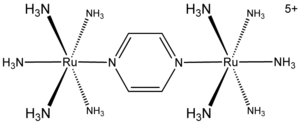- Creutz-Taube complex
-
The Creutz-Taube ion is the metal complex with the formula [Ru(NH3)5]2(C4H4N2)5+. This cationic species has been heavily studied in an effort to understand the intimate details of inner sphere electron transfer, that is, how electrons move from one metal complex to another. The ion is named after Carol Creutz, who first prepared the complex, and her thesis advisor Henry Taube, who received a Nobel Prize in Chemistry for this and related discoveries on electron-transfer.[1]
Properties
The complex consists of two "pentammine" (ammonia in metal complexes is referred to as ammine) ruthenium unit linked to the nitrogen atoms in a bridging pyrazine ligand, which completes the octahedral coordination sphere of each metal. The important feature of the compound is that the two metals have apparent fractional oxidation states of 2.5+. Normally metal ions, like most ions, have integral oxidation states. For example, ruthenium ammines are typically 2+ or 3+. The fact that the oxidation states are half-integral indicates that the two Ru(NH3)5 centers are equivalent in terms of their number of electrons. Crystallographic and theoretical studies are consistent with this description, i.e. the two metals are equivalent.[2][3] Characteristic of a mixed valence complex, this ion strongly absorbs light in the near-Infra-red part of the electromagnetic spectrum. In the case of the Creutz-Taube ion, the absorption maximum occurs at 1570 nm. This absorption is described as an intervalence charge-transfer band.
Synthesis
The ion was originally isolated as the hydrated salt ([Ru(NH3)5]2(C4H4N2)(O3SC6H4CH3)5.3H2O). It is prepared in two steps from the monoruthenium pyrazine complex:
- [Ru(NH3)5(C4H4N2)]2+ + [Ru(NH3)5(H2O)]2+ → [Ru(NH3)5]2(C4H4N2)]4+ + H2O
- [Ru(NH3)5]2(C4H4N2)]4+ + Ag+ → [Ru(NH3)5]2(C4H4N2)]5+ + Ag
The Creutz-Taube ion illustrates the advantages of ruthenium complexes for examining redox reactions. Ru(II) and Ru(III) ions can be interconverted at mild redox potentials or using conventional redox reagents. Importantly, coordination complexes of both of these oxidation states are kinetically inert, because they are both low-spin, d6 and d5, respectively. Many analogues of this ion have been prepared using different bridging ligands.
References
- ^ Creutz C.; Taube, H. “Direct Approach to Measuring the Franck-Condon Barrier to Electron Transfer Between Metal Ions” Journal of the American Chemical Society, 1969, volume 91, pp 3988-3989. doi:10.1021/ja01042a072; Henry Taube, Electron Transfer between Metal Complexes, Nobel Lecture, December 8, 1983, [1].
- ^ Fürholz, U.; Joss, S.; Bürgi, H. B.; Ludi, A. “The Creutz-Taube Complex Revisited: Crystallographic Study of the Electron-Transfer Series (μ-pyrazine)decaamminediruthenium ([(NH3)5Ru(Pyz)Ru(NH3)5]n+ (n = 4-6))” Inorganic Chemistry 1985, volume 24, pp 943 - 948. doi:10.1021/ic00200a028
- ^ K.s D. Demadis, C. M. Hartshorn, T. J. Meyer "The Localized-to-Delocalized Transition in Mixed-Valence Chemistry" Chem. Rev., 2001, 101 (9), pp 2655–2686. doi:10.1021/cr990413m
Categories:- Ruthenium compounds
- Coordination compounds
- Mixed valence compounds
Wikimedia Foundation. 2010.

